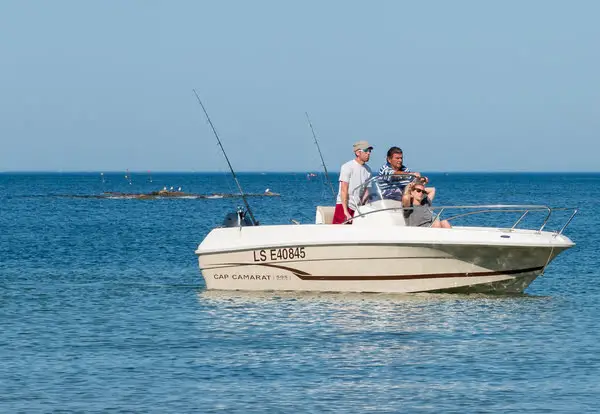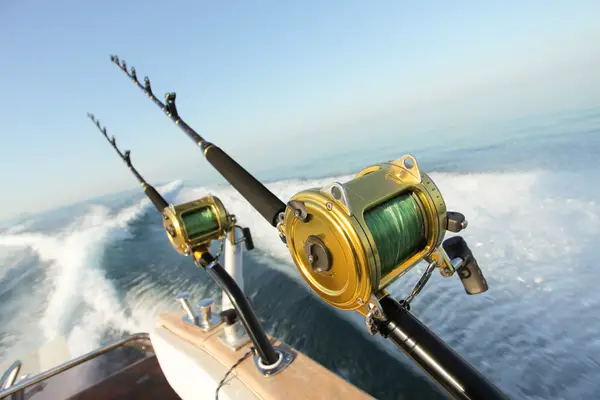Trolling is one of the most efficient ways of fishing with a rod and reel. It allows you to keep your lure at the perfect depth and speed to initiate a strike without having to cast over and over again.
Trolling for Spanish mackerel is a great idea because they are a perfect catch due to their aggression and swimming speed. They also inhabit many coastal waterways that are easily accessible by boat.
Table of Contents
- What Gear Should You Use?
- What Lures Should You Use While Trolling For Spanish Mackerel?
- How Fast Should You Troll?
- What Depth Should You Troll At?
- Where Should You Troll?
- Conclusion
What Gear Should You Use?
What do you need to start trolling for Spanish mackerel? Well unless you plan on swimming your lures around, you will need a boat.
Any boat that you can fish from will work. I’ve trolled from kayaks, sailboats, and powerboats. A powerboat is ideal for Spanish mackerel because they often prefer high speeds, but they will bite lures at lower speeds as well.

Your rod should be under 8 feet to keep it manageable on a boat and I would recommend a medium power and fast action.
Medium-light and medium-heavy will also work, but make sure your rod has enough backbone to withstand the fast trolling speeds.
For your reel, any spinning reel between 2500 and 5000 sizes should work well. It should have enough line capacity to tow the lure away from the boat and have fishing line left in case the fish drags along.
For this reason, I would highly recommend using braid for your main line, as it allows for more capacity with the same strength. Any braid above 10-pound test will work.
Your leader line should be at least 20-pound test mono or flouro, as mackerel have blade-like teeth that can instantly snap your line.
Size up your leader when the water is murky and size down when it is clearer because Spanish mackerel have great eyesight.
Some people use a few inches of wire in front of the lure to prevent break-offs, but you should only do this if absolutely necessary or it may reduce the number of bites.
A barrel swivel on your line is a must-have while trolling. Any twists caused by your lure will be amplified by the high speeds needed to troll.
Other common but not necessary pieces of gear are planers and trolling weights.
Planers are flat pieces of metal that use water resistance to keep your lure at a certain depth and trolling weights are tied in the middle of your line to sink your lures down to the desired depth.
Both of these are helpful when using lighter lures that don’t sink or dive in the current.
What Lures Should You Use While Trolling For Spanish Mackerel?
Spanish Mackerel will hit a variety of lures, but some of them are more equipped for trolling than others.
You ideally want something that has a lot of action on its own, with lots of vibration, flash, and wobble to attract the fish without needing any action from the angler.
According to the North Carolina Department of Environmental Quality, fishermen often catch large Spanish mackerel by trolling with a flashy lure!
Additionally, it needs to be able to stand up to the sharp teeth and hard hits of a Spanish mackerel.
The Rapala X-Rap is a great choice when trolling for Spanish mackerel. These lures come in a range of lip sizes, allowing you to fish at different depths. The X-Rap has a wide side-to-side action that draws fish in from far away.
The Yo-Zuri crystal minnow is another very effective trolling lure.
They usually swim shallower than X-Raps and have a tight wobble with lots of vibration that is good for attracting fish even in low clarity conditions.
The original Clarkspoon is probably the most tried and true Spanish mackerel lure. These flash and shake when trolled but will need a planer or weight to get them below the surface.
Other heavier spoons like Kastmasters and jigging spoons are also effective and don’t always need help getting to the desired depth.
How Fast Should You Troll?

Spanish mackerel are capable of moving at high speeds, meaning that you can troll very fast to get them excited.
They will hit lures at as low as 3 knots, but between 5 and 7 knots is the sweet spot. The speed at which Spanish mackerel move can also impact how fast you should troll.
This will get them fired up and ready to strike while also helping you avoid less desirable fish. Generally, as the water temperature heats up you want to increase speed and as it cools, decrease speed.
What Depth Should You Troll At?
Spanish mackerel occupy many different depths in the water column but like to hunt near the surface. Trolling in the top 10 feet of water is usually the best option and most strikes happen around 5 to 6 feet below the surface.
The best advice is to just pay attention to your surroundings. Do you see a lot of action on the surface with diving birds and baitfish? Set your troll to more shallow settings.
If you are marking a lot and bait deep on your fish finder than try slowing down and trolling deeper.
Where Should You Troll?
Spanish mackerel live in coastal areas around beaches and in inshore waters. The best places to fish for them are right off the beach to about 10 miles offshore. Reefs, wrecks, and other structures are great places to find schools.
Spanish Mackerel run from Maine to Texas throughout the year, following baitfish migrations and changing water temperatures. Increase your chances by timing your fishing days when mackerel are in your area.
If you are fishing offshore, look for bait jumping at the surface or birds diving.
This indicates that a large feeding event might be going on. Troll along the edge of these schools for the best results.
Driving your boat near inlets is extremely effective if you prefer to troll inshore. Go back and forth across the inlet to hook up on any fish entering or exiting the ocean with the tides. Fishing these areas when the water is flowing is most effective.
Conclusion
Trolling is a super effective way to catch fish and Spanish mackerel are a great candidate to target.
There are tons of different ways to troll for Spanish mackerel that can all be a blast. Additionally, Spanish mackerel can be good to eat, making them a great fish to seek out! Go out and experiment to find the method that works best for you!

Growing up in Florida, I’ve been surrounded by saltwater my entire life…and I love sharing my passion with others.
To learn more about why I started Saltwater Mecca, visit the ABOUT page.
Thank you for reading this article. Browse around & have some fun!